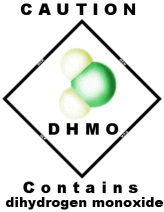------------------------------------------------------------------------------MATERIAL SAFETY DATA SHEET FOR DIHYDROGEN MONOXIDE------------------------------------------------------------------------------PRODUCT NAME: DIHYDROGEN MONOXIDEFORMULA WT: 18.00CAS NO.: 07732-18-5NIOSH/RTECS NO.: ZC0110000COMMON SYNONYMS: DIHYDROGEN OXIDE, HYDRIC ACIDPRODUCT CODES: 4218,4219 EFFECTIVE: 05/30/86 REVISION #01 LABORATORY PROTECTIVE EQUIPMENTSAFETY GLASSES; LAB COATPRECAUTIONARY LABEL STATEMENTSSTORAGE: KEEP IN TIGHTLY CLOSED CONTAINER.BOILING POINT: 100 C ( 212 F) VAPOR PRESSURE(MM HG): 17.5MELTING POINT: 0 C ( 32 F) VAPOR DENSITY(AIR=1): N/ASPECIFIC GRAVITY: 1.00 EVAPORATION RATE: N/ASOLUBILITY(H2O): COMPLETE (IN ALL PROPORTIONS) % VOLATILES BY VOLUME: 100APPEARANCE & ODOR: ODORLESS, CLEAR COLORLESS LIQUID.TOXICITY: LD50 (IPR-MOUSE)(G/KG) - 190 LD50 (IV-MOUSE) (MG/KG) - 25DISPOSAL PROCEDURE DISPOSE IN ACCORDANCE WITH ALL APPLICABLE FEDERAL, STATE, AND LOCAL ENVIRONMENTAL REGULATIONS.SAF-T-DATA(TM) STORAGE COLOR CODE: ORANGE (GENERAL STORAGE)SPECIAL PRECAUTIONS KEEP CONTAINER TIGHTLY CLOSED. SUITABLE FOR ANY GENERAL CHEMICAL STORAGE AREA. DIHYDROGEN MONOXIDE IS CONSIDERED A NON-REGULATED PRODUCT, BUT REACTS VIGOROUSLY WITH SOME MATERIALS. THESE INCLUDE SODIUM, POTASSIUM AND OTHER ALKALI METALS; ELEMENTAL FLUORINE; AND STRONG DEHYDRATING AGENTS SUCH AS SULFURIC ACID. IT FORMS EXPLOSIVE GASES WITH CALCIUM CARBIDE. AVOID CONTACT WITH ALL MATERIALS UNTIL INVESTIGATION SHOWS SUBSTANCE IS COMPATIBLE. EXPANDS SIGNIFICANTLY UPON FREEZING. DO NOT STORE IN RIGID CONTAINER AND PROTECT FROM FREEZING.DOMESTIC (D.O.T.)PROPER SHIPPING NAME CHEMICALS, N.O.S. (NON-REGULATED)INTERNATIONAL (I.M.O.)PROPER SHIPPING NAME CHEMICALS, N.O.S. (NON-REGULATED)------------------------------------------------------------------------------










